
Papilio glaucus, the eastern tiger swallowtail, is a species of butterfly native to eastern North America. It is one of the most familiar butterflies in the eastern United States, where it is common in many different habitats and travels as far North as Winnipeg Manitoba, Canada. It flies from spring then falls, during which it produces two to three broods. Adults feed on the nectar of many species of flowers, mostly from those of the families Apocynaceae, Asteraceae, and Fabaceae. P. glaucus has a wingspan measuring 7.9 to 14 cm. The male is yellow with four black "tiger stripes" on each forewing. Females may be either yellow or black, making them dimorphic. The yellow morph is similar to the male, but with a conspicuous band of blue spots along the hindwing, while the dark morph is almost completely black.

Swallowtail butterflies are large, colorful butterflies in the family Papilionidae, and include over 550 species. Though the majority are tropical, members of the family inhabit every continent except Antarctica. The family includes the largest butterflies in the world, the birdwing butterflies of the genus Ornithoptera.
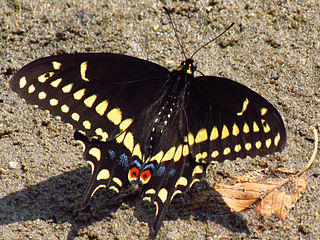
Papilio polyxenes, the (eastern) black swallowtail, American swallowtail or parsnip swallowtail, is a butterfly found throughout much of North America. It is the state butterfly of Oklahoma and New Jersey. An extremely similar-appearing species, Papilio joanae, occurs in the Ozark Mountains region, but it appears to be closely related to Papilio machaon, rather than P. polyxenes. The species is named after the figure in Greek mythology, Polyxena, who was the youngest daughter of King Priam of Troy. Its caterpillar is called the parsley worm because the caterpillar feeds on parsley.
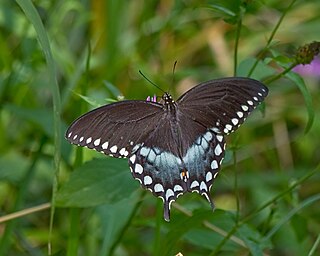
Papilio troilus, the spicebush swallowtail or green-clouded butterfly, is a common black swallowtail butterfly found in North America. It has two subspecies, Papilio troilus troilus and Papilio troilus ilioneus, the latter found mainly in the Florida peninsula. The spicebush swallowtail derives its name from its most common host plant, the spicebush, members of the genus Lindera.

Papilio rutulus, the western tiger swallowtail, is a swallowtail butterfly belonging to the Papilionidae family. The species was first described by Hippolyte Lucas in 1852.

Papilio zelicaon, the anise swallowtail, is a common swallowtail butterfly of western North America. Both the upper and lower sides of its wings are black, but the upper wing has a broad yellow stripe across it, giving the butterfly an overall yellow appearance. There are striking blue spots on the rear edge of the rear wing, and the characteristic tails of the swallowtails. Its wingspan is 52–80 mm. Its body is somewhat shorter than the rather similar western tiger swallowtail, with which its range overlaps; it also lacks the black stripes, converging toward the tail, of the latter. There is a somewhat darker subspecies, P. z. nitra, which is rare throughout the range, though somewhat more often found at lower elevations.

The scarce swallowtail is a butterfly belonging to the family Papilionidae. It is also called the sail swallowtail or pear-tree swallowtail.

Papilio multicaudata, the two-tailed swallowtail, is a species of the family Papilionidae found in western North America from British Columbia to Central America.

Papilio machaon, the Old World swallowtail, is a butterfly of the family Papilionidae. The butterfly is also known as the common yellow swallowtail or simply the swallowtail. It is the type species of the genus Papilio. This widespread species is found in much of the Palearctic and in North America.

Papilio demoleus is a common and widespread swallowtail butterfly. The butterfly is also known as the lime butterfly, lemon butterfly, lime swallowtail, and chequered swallowtail. These common names refer to their host plants, which are usually citrus species such as the cultivated lime. Unlike most swallowtail butterflies, it does not have a prominent tail. The butterfly is a pest and invasive species, found from Asia to Australia. The butterfly has spread to Hispaniola island in the Western Hemisphere, and to Mahé, Seychelles.

Papilio demodocus, the citrus swallowtail or Christmas butterfly, is a swallowtail butterfly which commonly occurs over the entirety of sub-Saharan Africa, including Madagascar, besides the southern Arabian Peninsula. The caterpillars feed on various native plants of especially the family Rutaceae, but have also taken to the leaves of cultivated citrus trees.

Papilio aegeus, the orchard swallowtail butterfly or large citrus butterfly is a species of butterfly from the family Papilionidae, that is found in eastern Australia and Papua New Guinea.
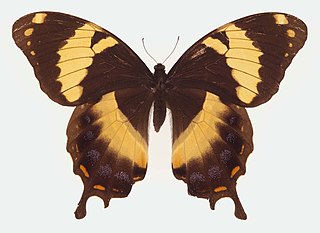
Papilio homerus, commonly known as the Homerus swallowtail or Jamaican swallowtail, is the largest butterfly species in the Western Hemisphere. The species is endangered and faces a potentially bleak future. Only two small populations of the Homerus swallowtail remain in a fraction of their original environment. It is endemic to Jamaica where the butterfly simultaneously serves as an icon of national pride and a need for conservation efforts. Over the past half century, the Jamaican swallowtail has been featured on various postal stamps and the Jamaican $1000 bill. In the face of rapid habitat destruction from human disruption and illegal collecting, the Jamaican swallowtail is listed on the Threatened Swallowtail Butterflies of the World by the International Union for Conservation of Nature and is protected under international and national level legislation.

Graphium macleayanus, the Macleay's swallowtail, is a butterfly belonging to the family Papilionidae. The species was named after Alexander Macleay.
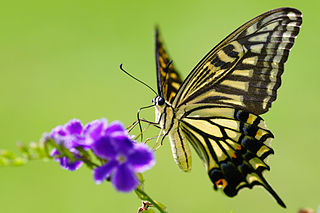
Papilio xuthus, the Asian swallowtail, Chinese yellow swallowtail or Xuthus swallowtail, is a yellow-colored, medium to large sized swallowtail butterfly found in northeast Asia, northern Myanmar, southern China, Taiwan, the Korean Peninsula, Japan, Siberia and the Hawaiian Islands. It was also recorded in the state of Arunachal Pradesh, India, in 2014.

Papilio appalachiensis, the Appalachian tiger swallowtail, is a species of swallowtail butterfly found in eastern North America, particularly in the Appalachian Mountains. It is a hybrid of another two Papilio species, Papilio canadensis and Papilio glaucus, with which it shares many characteristics. The butterflies are normally yellow and contain black patterns in their wings. Their wingspans range from 86 to 115 mm. The caterpillars range in color from green and yellow to orange and are ornamented with black specks that give them the appearance of a bird dropping, which is useful for camouflage, or a large eye, a form of mimicry that is also efficient for protection. This species is univoltine. Females lay their eggs in May.

Papilio canadensis, the Canadian tiger swallowtail, is a species of butterfly in the family Papilionidae. It was once classified as a subspecies of Papilio glaucus.

Papilio palamedes, the Palamedes swallowtail or laurel swallowtail, is a North American butterfly in the family Papilionidae.

Papilio aristodemus, the Schaus' swallowtail or island swallowtail, is a species of American butterfly in the family Papilionidae. It is found in southern Florida in the United States and throughout the West Indies. It is named in honor of William Schaus.
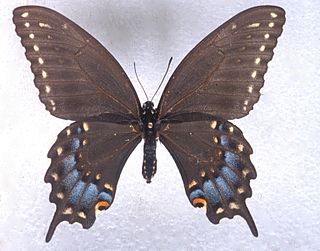
Papilio joanae, the Ozark swallowtail, is a North American butterfly species in the family Papilionidae. It was once considered a synonym of the black swallowtail.




















